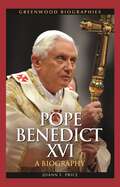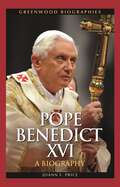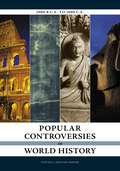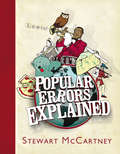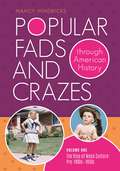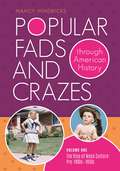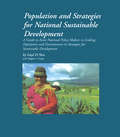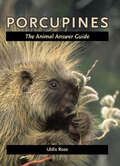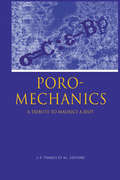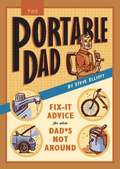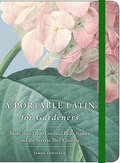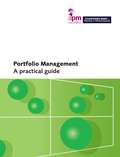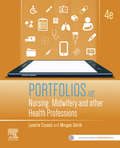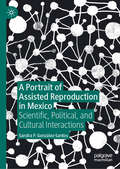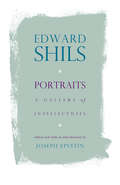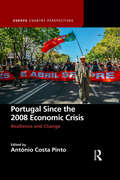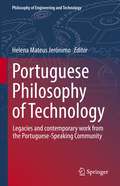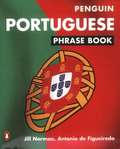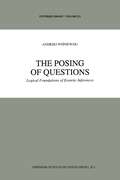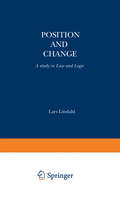- Table View
- List View
Pope Benedict XVI: A Biography (Greenwood Biographies)
by Joann F. PriceThis comprehensive biography of Pope Benedict XVI emphasizes his theological positions and contributions as a theologian.Pope Benedict XVI: A Biography is an incisive exploration of the life and career of the current head of the Roman Catholic Church, with an emphasis on his theological positions and contributions as a theologian. Written by a Catholic priest who is an expert on Bavarian theology, the book looks at Benedict's family life, his teen years in Nazi Germany, his rise in the Church, and the beliefs that shape his Papacy.Readers of this biography will learn that, in addition to his native German, Benedict XVI speaks Italian, French, English, Spanish, and Latin fluently, has a knowledge of Portuguese, and can read ancient Greek and biblical Hebrew. They will discover that he plays the piano and is very fond of cats. Perhaps surprisingly, they will find that during the time of the Second Vatican Council, the Pope was viewed as a reformer, and that he continues to regard himself as a supporter of the Council's teaching, holding, however, that those teachings have been widely misinterpreted. All this and more make for a fascinating—and instructive—reading experience.
Pope Benedict XVI: A Biography (Greenwood Biographies)
by Joann F. PriceThis comprehensive biography of Pope Benedict XVI emphasizes his theological positions and contributions as a theologian.Pope Benedict XVI: A Biography is an incisive exploration of the life and career of the current head of the Roman Catholic Church, with an emphasis on his theological positions and contributions as a theologian. Written by a Catholic priest who is an expert on Bavarian theology, the book looks at Benedict's family life, his teen years in Nazi Germany, his rise in the Church, and the beliefs that shape his Papacy.Readers of this biography will learn that, in addition to his native German, Benedict XVI speaks Italian, French, English, Spanish, and Latin fluently, has a knowledge of Portuguese, and can read ancient Greek and biblical Hebrew. They will discover that he plays the piano and is very fond of cats. Perhaps surprisingly, they will find that during the time of the Second Vatican Council, the Pope was viewed as a reformer, and that he continues to regard himself as a supporter of the Council's teaching, holding, however, that those teachings have been widely misinterpreted. All this and more make for a fascinating—and instructive—reading experience.
Popular Controversies in World History [4 volumes]: Investigating History's Intriguing Questions [4 volumes]
Covering prehistoric times to the modern era, this fascinating resource presents pro-and-con arguments regarding unresolved, historic controversies throughout the development of the world.Popular Controversies in World History: Investigating History's Intriguing Questions offers uniquely compelling and educational examinations of pivotal events and puzzling phenomena, from the earliest evidence of human activity to controversial events of the 20th century.From the geographic location of human origins, to the authenticity of the Shroud of Turin, to the innocence—or guilt—of Sacco and Vanzetti, Popular Controversies in World History: Investigating History's Intriguing Questions provides four volumes on the ongoing debates that have captivated both the historical community and the public at large. In each chapter, established experts offer credible opposing arguments pertaining to specific debates, providing readers with resources for independent critical thinking on the issue. This format allows students, scholars, and other interested readers to actively engage in some of the most intriguing conundrums facing historians today.
Popular Errors Explained
by Stewart McCartneyIn 1841 John Timbs wrote a book called Popular Errors Explained. It went on - with Timbs' other great series 'Curiosities of ...' - to become one of the great popular books of the 19th century, running into many editions and selling hundreds of thousands of copies. Some say the popularity of his one hundred and fifty volumes led him to outsell a certain Mr Dickens.Stewart McCartney, under the Timb's title of Popular Errors Explained has created a new book, capturing the zeal and enthusiasm of the original, to be 'agreeable, by way of abstract and anecdote so as to become an advantageous and amusing guest at any intellectual fireside.' The book has completely new material - around 200 or so 'popular errors' from science and literature, history, sport, popular culture and so on. Each entry will have that eyebrow raising 'I didn't know that!' or 'Surely that cannot be true!' feel. Every one will explode a commonly held misbelief.
Popular Fads and Crazes through American History [2 volumes]: [2 volumes]
by Nancy HendricksThis informative two-volume set provides readers with an understanding of the fads and crazes that have taken America by storm from colonial times to the present. Entries cover a range of topics, including food, entertainment, fashion, music, and language.Why could hula hoops and TV westerns only have been found in every household in the 1950s? What murdered Russian princess can be seen in one of the first documented selfies, taken in 1914? This book answers those questions and more in its documentation of all of the most captivating trends that have defined American popular culture since before the country began. Entries are well-researched and alphabetized by decade. At the start of every section is an insightful historical overview of the decade, and the set uniquely illustrates what today's readers have in common with the past. It also contains a Glossary of Slang for each decade as well as a bibliography, plus suggestions for further reading for each entry. Students and readers interested in history will enjoy discovering trends through the years in such areas as fashion, movies, music, and sports.
Popular Fads and Crazes through American History [2 volumes]: [2 volumes]
by Nancy HendricksThis informative two-volume set provides readers with an understanding of the fads and crazes that have taken America by storm from colonial times to the present. Entries cover a range of topics, including food, entertainment, fashion, music, and language.Why could hula hoops and TV westerns only have been found in every household in the 1950s? What murdered Russian princess can be seen in one of the first documented selfies, taken in 1914? This book answers those questions and more in its documentation of all of the most captivating trends that have defined American popular culture since before the country began. Entries are well-researched and alphabetized by decade. At the start of every section is an insightful historical overview of the decade, and the set uniquely illustrates what today's readers have in common with the past. It also contains a Glossary of Slang for each decade as well as a bibliography, plus suggestions for further reading for each entry. Students and readers interested in history will enjoy discovering trends through the years in such areas as fashion, movies, music, and sports.
Population and Strategies for National Sustainable Development: A guide to assist national policy makers in linking population and environment in strategies for development
by Gayl D Ness Meghan V GolayThe guide serves as a resource for national-level policy makers and the staff of conservation organizations who wish to integrate population and environmental conditions in planning for sustainable development. It presents the basic rationale for linking population and environmental issues, including the demonstrable impact that growth in population and consumption is having on the environment. At the same time, it acknowledges the difficulty of achieving integration due to long-entrenched disciplinary and institutional specialization. The guide refrains from making blanket prescriptions, but rather emphasizes that policy and planning responses must be attuned to the location-specific nature of population-environment interactions. A number of mechanisms for achieving integration are presented, including placement of demographers within national planning organizations, or creation of country-based networks of population and conservation professionals who meet regularly to share knowledge and experience. For those less familiar with previous research, the book includes a primer on demographic change and models and frameworks for understanding the links between population dynamics (births, deaths, growth, migration) and environmental change.Originally published in 1996
Population and Strategies for National Sustainable Development: A guide to assist national policy makers in linking population and environment in strategies for development (Health And Population Set Ser.)
by Gayl D Ness Meghan V GolayThe guide serves as a resource for national-level policy makers and the staff of conservation organizations who wish to integrate population and environmental conditions in planning for sustainable development. It presents the basic rationale for linking population and environmental issues, including the demonstrable impact that growth in population and consumption is having on the environment. At the same time, it acknowledges the difficulty of achieving integration due to long-entrenched disciplinary and institutional specialization. The guide refrains from making blanket prescriptions, but rather emphasizes that policy and planning responses must be attuned to the location-specific nature of population-environment interactions. A number of mechanisms for achieving integration are presented, including placement of demographers within national planning organizations, or creation of country-based networks of population and conservation professionals who meet regularly to share knowledge and experience. For those less familiar with previous research, the book includes a primer on demographic change and models and frameworks for understanding the links between population dynamics (births, deaths, growth, migration) and environmental change.Originally published in 1996
Porcupines: The Animal Answer Guide (The Animal Answer Guides: Q&A for the Curious Naturalist)
by Uldis RozeCould a porcupine make a good pet? Do they ever stick themselves or other porcupines with their quills? In this latest addition to the Animal Answer Guide series, we learn about these mysterious animals' "pincushion defense," along with the following facts:• Porcupines survive on a diet of leaves, bark, and fruit• Quills are actually modified hairs• There are 26 species of porcupines (and counting)• Old World and New World porcupines have a common ancestor but evolved independently• New World males will gather to fight ferociously over a single femalePorcupines: The Animal Answer Guide presents solid, current science in the field of porcupine biology. Uldis Roze compares and contrasts porcupines in terms of body plan, behavior, ecology, reproduction, and evolutionary relationships. He examines the diversity of porcupines from around the world—from North and South America to Africa and Asia.This guide explores the interactions between humans and porcupines, including hunting, use of quills by aboriginal societies, efforts to poison porcupines, and human and pet injuries (and deaths) caused by porcupines. Roze also highlights the conservation issues that surround some porcupine species, such as the thin-spine porcupine of Brazil, which is so rare that it was thought to be extinct until its rediscovery in the 1980s.
Porcupines: The Animal Answer Guide (The Animal Answer Guides: Q&A for the Curious Naturalist)
by Uldis RozeCould a porcupine make a good pet? Do they ever stick themselves or other porcupines with their quills? In this latest addition to the Animal Answer Guide series, we learn about these mysterious animals' "pincushion defense," along with the following facts:• Porcupines survive on a diet of leaves, bark, and fruit• Quills are actually modified hairs• There are 26 species of porcupines (and counting)• Old World and New World porcupines have a common ancestor but evolved independently• New World males will gather to fight ferociously over a single femalePorcupines: The Animal Answer Guide presents solid, current science in the field of porcupine biology. Uldis Roze compares and contrasts porcupines in terms of body plan, behavior, ecology, reproduction, and evolutionary relationships. He examines the diversity of porcupines from around the world—from North and South America to Africa and Asia.This guide explores the interactions between humans and porcupines, including hunting, use of quills by aboriginal societies, efforts to poison porcupines, and human and pet injuries (and deaths) caused by porcupines. Roze also highlights the conservation issues that surround some porcupine species, such as the thin-spine porcupine of Brazil, which is so rare that it was thought to be extinct until its rediscovery in the 1980s.
Poromechanics: Proceedings of the 1st Biot conference
by J. F. ThimusThis text features 105 papers dealing with the fundamentals and the applications of poromechanics from the Biot conference of 1998, held in Louvain-la-Neuve. Topics include: wave propogation; numerical modelling; identification of poromechanical parameters; and constitutive modelling.
Poromechanics: Proceedings of the 1st Biot conference
by J. F. Thimus Et Et AlThis text features 105 papers dealing with the fundamentals and the applications of poromechanics from the Biot conference of 1998, held in Louvain-la-Neuve. Topics include: wave propogation; numerical modelling; identification of poromechanical parameters; and constitutive modelling.
The Portable Dad: Fix-It Advice for When Dad's Not Around
by Steve ElliottFor college students, twentysomethings, and anyone else who keeps Dad on speed-dial for car emergencies, plumbing woes, appliance advice, and more. Take Dad's know-how with you everywhere you go! This Dad's got all the answers to all the basics, so that you can get it done and move on. He knows how to hang, unclog, patch, drill, paint, mow, lube, edge, weed, sand, pack, and more. The Portable Dad is the answer to those panicked late-night phone calls: how to keep things running, how to maintain the stuff you use, how to get by without getting in over your head. If Dad doesn't know the answer, you don't really need to do it!
A Portable Latin for Gardeners: More than 1,500 Essential Plant Names and the Secrets They Contain
by James ArmitageHaving an understanding of botanical Latin unlocks an entirely new layer of the plant world. Gardeners deciding between a Crocus flavus and Crocus graveolens will know that one produces deep yellow flowers while the other boasts a prominent smell. They can tell whether a plant should have one (unifolius), two (diphyllus), or even nine leaves (enneaphyllus). And they can catch the nods to Sir Joseph Banks in Cordyline banksia and Queen Victoria in Agave victoriae-reginae. A Portable Latin for Gardeners is the perfect quick reference for working in the garden, shopping for plants, or doing botanical research—and no prior knowledge of Latin is required. The 1,500 terms are grouped by categories, making it easy to describe color, size, form, habitat, scent, taste, and time. Gardeners will make new connections and discoveries in a way standard alphabetical lists simply don’t allow. Alternately, gardeners who want to look up a particular term can jump right into the alphabetical index. Each entry includes the different forms of the term, a basic pronunciation guide, the definition, and an example plant species. Rich botanical illustrations make this guide as beautiful as it is useful, while a durable flexi-bound cover means the book can withstand both days in the garden and evenings on the nightstand.
A Portable Latin for Gardeners: More than 1,500 Essential Plant Names and the Secrets They Contain
by James ArmitageHaving an understanding of botanical Latin unlocks an entirely new layer of the plant world. Gardeners deciding between a Crocus flavus and Crocus graveolens will know that one produces deep yellow flowers while the other boasts a prominent smell. They can tell whether a plant should have one (unifolius), two (diphyllus), or even nine leaves (enneaphyllus). And they can catch the nods to Sir Joseph Banks in Cordyline banksia and Queen Victoria in Agave victoriae-reginae. A Portable Latin for Gardeners is the perfect quick reference for working in the garden, shopping for plants, or doing botanical research—and no prior knowledge of Latin is required. The 1,500 terms are grouped by categories, making it easy to describe color, size, form, habitat, scent, taste, and time. Gardeners will make new connections and discoveries in a way standard alphabetical lists simply don’t allow. Alternately, gardeners who want to look up a particular term can jump right into the alphabetical index. Each entry includes the different forms of the term, a basic pronunciation guide, the definition, and an example plant species. Rich botanical illustrations make this guide as beautiful as it is useful, while a durable flexi-bound cover means the book can withstand both days in the garden and evenings on the nightstand.
Portfolio Management – A practical guide
by Association for Project ManagementThis guide illustrates how portfolio management is a key mechanism in enabling an organisation to optimise delivery of its strategic goals, maximising value, and do so in the required time frame. The guide is designed to serve three main aims: to promote awareness of, and outline good practice in, portfolio management for the practising or developing portfolio manager or portfolio office manager. All organisations can learn from each other, but ultimately each needs to build its own version of portfolio management practice that addresses their own business need; to provide a benchmark for portfolio managers and the portfolio management community to assess their own organisation’s maturity in the discipline; to stimulate new thinking and contribute to the development of portfolio management practice.
Portfolios for Nursing, Midwifery and other Health Professions, E-Book
by Lynette Cusack Morgan SmithPortfolios for Nursing, Midwifery and other Health Professions is a practical guide providing detailed strategies for developing a quality portfolio that will assist you to review your professional practice, assess your learning and career planning, direct your continuing professional development and effectively communicate your professional achievements. Written by Lynette Cusack and Morgan Smith, this fourth edition will help you understand the drivers and benefits of portfolios and how to design and evaluate a quality portfolio in order to meet the Australian Health Practitioner Regulation Agency (AHPRA) annual registration requirements. Clearly outlines what a portfolio is, how it is used and why different types of portfolios are required for different purposesSupports understanding of the relationship between portfolios and the AHPRA regulatory requirements of self-declaration and practising in accordance with professional practice standardsAssists in understanding and applying reflection techniques in professional development, learning and portfolio use.An increased focus on how portfolios relate to career planning and achieving professional goalsHighlights different ways of demonstrating evidence of achievementsAn increased emphasis on demonstrating safety and quality in healthcare and person-centred practice
A Portrait of Assisted Reproduction in Mexico: Scientific, Political, and Cultural Interactions
by Sandra P. González-SantosThis book paints a comprehensive portrait of Mexico’s system of assisted reproduction first from a historical perspective, then from a more contemporary viewpoint. Based on a detailed analysis of books and articles published between the 1950s and 1980s, the first section tells the story of how the epistemic, normative, and material infrastructure of the assisted reproduction system was built. It traces the professionalization process of assisted reproduction as a medical field and the establishment of its professional association. Drawing on ethnographic material, the second part looks at how this system developed and flourished from the 1980s up to 2010, its commercialization process, how the expansion of reproductive services took place, and the messages regarding reproductive technologies that circulated within a wide discursive landscape. Given its scope and methods, this book will appeal to scholars interested in science and technology studies, reproduction studies, history of medicine, medical anthropology, and sociology.
Portraits: A Gallery of Intellectuals
by Edward ShilsIn these vivid portraits of prominent twentieth-century intellectuals, Edward Shils couples the sensitivity of a biographer with the profound knowledge of a highly respected scholar. Ranging as widely across various disciplines as Shils himself did, the essays gathered here share a distaste for faddists who "run with the intellectual mob" and a deep respect for intellectuals who maintain their integrity under great pressure. Highlights include an affectionate treatment of Leo Szilard, the physicist whose involvement with the development of the atomic bomb led him to work ceaselessly to address its social consequences; a discussion of the educational philosophy of Robert Maynard Hutchins, the University of Chicago's fifth and most controversial president; an appreciative account of the Polish emigré Leopold Labedz's well-informed and outspoken resistance to Communism; and an essay about the extraordinary Indian writer Nirad Chaudhuri. Many of these essays have appeared in The American Scholar, edited by Joseph Epstein, who introduces this volume with his own portrait of Edward Shils. "Though professionally a sociologist, Edward Shils was a man of wide cosmopolitan culture and experience, greatly concerned with the public problems of his time: in particular with those created by the rise of new and dangerous ideologies, the frightening possibilities of science, and the apparent abrogation of public responsibility by many Western intellectuals."—Hugh Trevor-Roper The late Edward Shils was a member of the University of Chicago's Committee on Social Thought for forty-five years and a fellow of Peterhouse, Cambridge University. His many books include The Calling of Sociology and The Intellectuals and the Powers, both published by the University of Chicago Press.
Portugal Since the 2008 Economic Crisis: Resilience and Change (Europa Country Perspectives)
by António Costa PintoPortuguese democracy is now celebrating its 50th anniversary. Portugal joined the European Union (EU) in 1986, but the enduring legacies of the country’s transition process from authoritarianism to democracy became apparent during the European sovereign debt crisis, when Portugal experienced its third bailout since the institutionalization of democratic government. Although the first decade after EU accession was one of slight growth and investment, Portugal’s economy has, in effect, been performing poorly since the beginning of the 21st century. Among the major changes in Portuga - as in much of Southern Europe - as a result of the ‘great recession’, was the emergence of important new actors, including populist parties, new social movements and the polarization of attitudes toward the EU. In some of these areas, the phrase ‘with the exception of Portugal’ was always present. This book explores the factors that might explain why this is no longer the case, presenting a global overview, with an interdisciplinary focus, of the processes of economic, social and political changes in Portuguese democracy since the 2008 economic crisis. The volume is accessible to a broad academic audience, with chapters examining economic, political, social and foreign policy issues, for scholars interested in an analysis of Portugal’s emergence from the economic crisis.
Portugal Since the 2008 Economic Crisis: Resilience and Change (Europa Country Perspectives)
by António Costa PintoPortuguese democracy is now celebrating its 50th anniversary. Portugal joined the European Union (EU) in 1986, but the enduring legacies of the country’s transition process from authoritarianism to democracy became apparent during the European sovereign debt crisis, when Portugal experienced its third bailout since the institutionalization of democratic government. Although the first decade after EU accession was one of slight growth and investment, Portugal’s economy has, in effect, been performing poorly since the beginning of the 21st century. Among the major changes in Portuga - as in much of Southern Europe - as a result of the ‘great recession’, was the emergence of important new actors, including populist parties, new social movements and the polarization of attitudes toward the EU. In some of these areas, the phrase ‘with the exception of Portugal’ was always present. This book explores the factors that might explain why this is no longer the case, presenting a global overview, with an interdisciplinary focus, of the processes of economic, social and political changes in Portuguese democracy since the 2008 economic crisis. The volume is accessible to a broad academic audience, with chapters examining economic, political, social and foreign policy issues, for scholars interested in an analysis of Portugal’s emergence from the economic crisis.
Portuguese Philosophy of Technology: Legacies and contemporary work from the Portuguese-Speaking Community (Philosophy of Engineering and Technology #43)
by Helena Mateus JerónimoThis volume is a collection of essays of a philosophical nature on the subject of technology, introducing authors from the Portuguese-speaking community, namely from Portugal itself, Africa and Brazil. Their contributions detail a unique perspective on technology, placing this important topic within the historical, ideological and social contexts of their countries, all of which share a common language. The shared history of these countries and the cultural and economic specificities of each one have stimulated singular insights into these thinkers’ reflections.The essays are thematically diverse. Among the topics covered are technogenic knowledge, visions of technology, risks and uncertainties, mediatization, digitalization, and datafication, engineering practice and ethics, alternative technoscientific strategies, ontotechnologies of the body, virtual and archive. The contributions also explore other themes that are more closely related to the semi-peripheral world, such as technological dependence and the incorporation of Western technology into the social structure of ancestral communities.This book appeals to students and researchers and provides a voice to authors whose work are not usually available in English-language publications. It serves as an ideal guide for all those who seek rigorous and geographically widespread knowledge regarding thinking on technology in several Portuguese-speaking countries.
Portuguese Phrase Book (Penguin Phrase Bks.)
by Antonio De Figueiredo Jill NormanThis Portuguese phrase book contains useful phrases for both business and pleasure. The book includes basic grammar, a pronunciation guide and additional vocabulary.
The Posing of Questions: Logical Foundations of Erotetic Inferences (Synthese Library #252)
by A. WisniewskiThis book is a study in the logic of questions (sometimes called erotetic logic). The central topics in erotetic logic have been the structure of questions and the question-answer relationship. This book doesn't neglect these problems, but much of it is focussed on other issues. The main subject is the logical analysis of certain relations between questions and the contexts of their appearance. And our aim is to elaborate the conceptual apparatus of the inferential approach to the logic of questions. Questions are asked for many reasons and for different purposes. Yet, before a question is asked or posed, a questioner must arrive at it. In many cases arriving at a question resembles coming to a conclusion: there are some premises involved and some inferential thought processes take place. If we agree that a conclusion need not be "conclusive", we may say that sometimes questions can play the role of conclusions. But questions can also perform the role of premises: we often pass from some "initial" question to another question. In other words, there are inferential thought processes - we shall call them erotetic inferences - in which questions play the roles of conclusions or conclusions and premises. The inferential approach to the logic of questions focusses its attention on the analysis of erotetic inferences. This book consists of eight chapters.
Position and Change: A Study in Law and Logic (Synthese Library #112)
by L. LindahlThe present study which I have subtitled A Study in Law and Logic was prompted by the question of whether an investigation into law and legal systems could lead to the discovery of unrevealed fundamental patterns common to all such systems. This question was further stimulated by two interrelated problems. Firstly, could an inquiry be rooted in specifically legal matters, as distinct from the more usual writings on deontic logic? Secondly, could such inquiry yield a theory which would nevertheless embrace a strict and simple logical structure, permitting substantive conclusions in legal matters to be deduced from simple rules governing some basic concepts? Before the development of deontic logic, W. N. Hohfeld devoted his efforts to this question at the beginning of this century. However, with this exception, few jurists have studied the interrelation between law and logic projected in this way. Nevertheless, two great names are to be found, Gottfried Wilhelm Leibniz and Jeremy Bentham-both philo sophers with legal as weIl as logical training. Bentham's investigations of logical patterns in law have only recently attracted attention; and as for Leibniz, his achievements are still almost totally unexplored (his most important writings on law and logic have not even been translated from Latin). My initial interest in the question was evoked by Professor Stig Kanger. Although primarily a logician and philosopher, Stig Kanger has been interested also in the fundamentals of legal theory.
